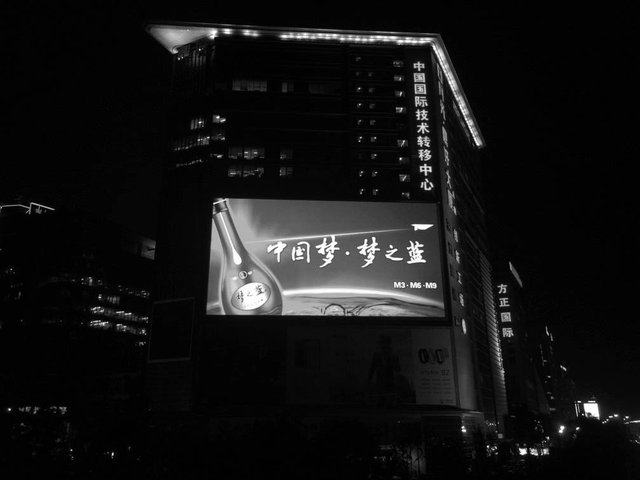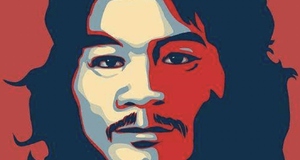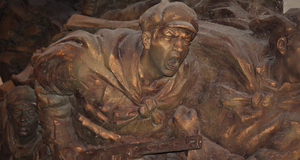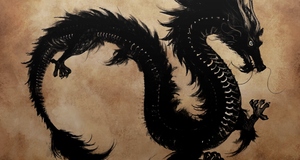From Cornell International Affairs Review VOL. 9 NO. 2Creating the Cult of Xi Jinping: The Chinese Dream as a Leader SymbolIntegration FunctionThe fourth function of leader symbols, the integration function, can be seen widely in Mao era leader symbols. The integration function helps to stabilize society by constantly forcing new institutions to integrate into the system dominated by leader symbols. If these symbols are then removed from the institutions of society, the institutions would be inherently different. One notable example of the integration function during the Mao era was the practice of reading Mao Zedong's Little Red Book daily. For members of the People's Liberation Army (PLA) in particular, this repetitive practice became a fundamental part of the institution of the PLA and constantly shaped the lives of soldiers as well as the Chinese people as a whole. Without this extremely powerful leader symbol and the important integration function it served, institutions were changed fundamentally. This is one of the reasons there was such a power vacuum after Mao's death. While the Little Red Book was a physical leader symbol that became regularized and integrated into state institutions and practices of everyday life, the same cannot yet be said for Xi Jinping's China Dream. The reason is that Xi has only been the leader of China for 3 years. Because the integration function takes place through a process of repetitive institutionalization, the leader symbols of Xi Jinping have not had an adequate amount of time to fully permeate existing institutions, such as the military and the education system, which played important roles in creating the cult of Mao. However, the extent to which Beijing's public spaces are dominated by China Dream art does show the potential for strong integration. In Beijing, valuable advertisement space on public walls, "jumbo-trons," billboards, and buildings is increasingly taken up by China Dream art. Some private companies are even incorporating the China Dream into their advertisements, further permeating public spaces and bridging the public-private divide. For example, a massive electronic billboard on the corner of Zhongguancun North Avenue and Beishuan West Road (on the southeast corner of Peking University) regularly showed an advertisement for a brand of baijiu (a type of liquor) called 梦之蓝 (mengzhilan "Blue Dream"). The advertisement, shown in Figure 7, says "中国梦 梦之蓝" ("China Dream – Blue Dream"). It is significant that a private company is incorporating the China Dream into its advertising, because it suggests that the term "China Dream" is no longer an empty phrase; it is now part of a widely recognizable brand created by Xi Jinping. In addition to private advertisements, the China Dream has been incorporated into schools and the Chinese education system in different forms. At some schools and universities, students are encouraged to write their China Dreams on "dream walls" on campus. There were even student singing competitions that eventually resulted in a "chart-topping folk song" based on the China Dream.35 Similarly, throughout July 2015 at Peking University, there were multiple signs advertising the event "Writing the Chinese Dream: China Youth Calligraphy Competition for Charity" ("书写中国梦:中华青少年书法公益比赛"). These examples show the increasing incorporation of China Dream leader symbols into China's education system, which, in addition to China Dream art's incorporation into commercial spaces, fulfills the integration function of leader symbols.Legitimacy Promotion FunctionThe fifth leader symbol function, legitimacy promotion, is perhaps the most important but also the most elusive for leaders to obtain. This paper has shown how leader symbols served to legitimize both Mao and Xi. For Mao's cult, leadership symbols such as the daily ritual of reading the Little Red Book, confessing in front of Mao's image, and of course propaganda art all served to build and sustain Mao's legitimacy. Similarly, practices such as calling Xi Jinping "Xi Dada," making public confessions of guilt, and the China Dream's emphasis on Confucian values and filial piety have all sought to bolster his public image and legitimacy. Yet neither Mao nor Xi has achieved legitimacy promotion on the scale of the Kim dynasty in North Korea. In North Korea, legitimacy promotion through leader symbols has been so strong that the legitimacy of the initial leader, Kim Il-sung was passed onto his son Kim Jong-il, and in 2011 passed onto his son, Kim Jong-un. In the North Korean leader state, the level of adoration for its leaders has surpassed a mere cult of personality. North Korean leaders are deified and worshipped to such an extent that their legitimacy has transgressed time and generations.37 North Korea is unique in the modern world for the extent to which the popular legitimacy of its leaders has been so thoroughly established. Neither the cults of Mao or Xi can claim to have been so successful in establishing legitimacy. After his death, Deng Xiaoping, one of China's greatest leaders, weakened Mao's legitimacy and cult by officially acknowledging that Mao's policies were 70 percent good and 30 percent bad.38 So even Mao's legitimacy does not stand up to that of the Kim dynasty. However, this does not mean that the legitimacy of Mao and Xi is insufficient to warrant them possessing cults of personality; as has been shown, their legitimacy too is deeply institutionalized and publicly shown. Mass Mobilization FunctionThe sixth and final function of leader symbols is mass mobilization. This function is very similar to the first function of communication, in that it involves the leader's ability to utilize leader symbols to achieve massive public mobilization to achieve the leader's aims. However, it differs slightly from the communication function because rather than asking the people to support a specific policy, the process of massive public mobilization itself serves to bolster the leader's legitimacy and leader status. Lim says that this most often takes the form of a "tour" by the leader.39 There are many examples of Mao carrying out acts of mass mobilization, including in the form of "tours." One such example is Mao's famous swimming of the Yangtze River on July 16, 1966. Mao's swim was widely publicized in the media to show that Mao was still fit to lead China and the Party, despite his advancing age. A year later, Mao embarked on his "Inspection Tour of the Three Regions," between July and September 1967. The inspection tour included several key provinces and cities in the North, Mid-South, and East of China. Over the course of the inspection tour, the media followed Mao to publicize his support of the Cultural Revolution and his call to end the factional violence that was going on between warring Red Guard factions.40 Mao's swim in the Yangtze helped to revitalize Mao's cult after the disastrous years of the Great Leap Forward, and the inspection tour consolidated his leadership status because it demonstrated that he had enough influence to quell the turmoil of Red Guard fighting. Thus, both events represent successful examples of the mass mobilization function. President Xi has also achieved mass mobilization in the form of tours similar to those of his predecessor Deng Xiaoping. In December 2012, soon after assuming the office of Party General Secretary, Xi Jinping went on his first official trip outside of Beijing. Like Deng Xiaoping, Xi traveled to the city of Shenzhen in Guangdong Province. Because of Shenzhen's status as a Special Economic Zone, the symbolic nature of this trip suggested that Xi will, like Deng, pursue economic reforms to promote China's economic growth. According to some observers, Xi played down the pomp of his official visit in order to focus on the issues; as a result, he gained a lot of public support for his actions.41 Another interesting "tour" was Xi's visit in 2013 to Qufu, the hometown of Confucius. He was the first Chinese leader to visit Qufu in two decades, and many noted the significance of the trip. An Economist article even referenced that it signified the union of the cult of Confucius with the cult of Xi.42 The southern tour to Guangdong represented a call for mass mobilization in achieving economic reforms. The Qufu trip represented a call for bringing back the morals and values of Confucius; it sought to legitimize Xi and the CCP by uniting them with one of the oldest cults in China, the cult of Confucius. Implications of the CultThis paper does not claim that the cult of Xi exists on the same scale as the Mao cult or the Kim dynasty. Cults of personality exist on a spectrum. Mao's cult never reached the extent of the Kims' cult, but it is still widely considered a cult of personality.43 Similarly, the Xi cult has not consolidated to the point that the Mao cult did; nor does this study predict that it will. Nevertheless, this paper argues that it is developing and consolidating into a functioning cult of personality. What, then, are the domestic and foreign implications? Within China, the most significant impact has been the changing nature of the relationship between Chinese citizens and the state. As Xi consolidates power over state institutions and begins to reshape China's society into a Confucian order, the relationship between Chinese citizens and Xi has transformed into a relationship of ruler and ruled. For viewers in liberal democracies, this shift towards a personality cult and stricter authoritarian rule is worrying. As A. T. Nuyen argues, Confucianism's emphasis on hierarchy and communitarianism make it incompatible with liberal conceptions of citizenship.44 However, Nuyen suggests that Confucianism might provide constructive critiques of liberalism by emphasizing the role of citizenship as constructed through the community, and by reshaping the concept of equality through citizens' roles in the community. Nuyen continues by saying that the claim that Confucianism is incompatible with democracy and equality needs to be reevaluated by applying a "thick" conception of citizenship rather than a "thin" one, like that of liberalism.45 However, Xi and the CCP do not seem to share this non-hierarchical conception of citizenship. China Dream propaganda art's particular emphasis on the Confucian value of filial piety suggests that, in the view of Xi and the CCP leadership, Confucianism's inherently hierarchical nature is useful for establishing a more stable order—with Xi and the Party at the top. Some have argued that there is sizable opposition to Xi within China, particularly among China's online "netizens." Chin-fu Hung argues that in the age of cyberspace and the internet, propaganda such as the China Dream campaign constantly runs up against "alternate discourses" that fight for ownership of discourse rights, both within physical spaces and especially on the Internet.46 Critics like Hung hold that, because of technologies like the internet, a cult of personality is not possible in contemporary China. Yet, at the same time, there is tremendous domestic support for President Xi. In fact, according to recent polls analyzed by Anthony Saich, Xi's public approval ratings make him the most popular leader in the world. His domestic approval, as previously stated, comes largely from support for his anti-corruption campaign and his social influence.47 The fact that he maintains overwhelming support domestically shows that, despite potential opposition from a small portion of society, his cult is well and strong. Moreover, as Lisa Wedeen points out, it does not even matter whether everyone legitimizes Xi or buys into his leader symbol of the China Dream; what is important is that they comply.48 In her view, in maintaining a personality cult, it is more important for a leader to force compliance rather than expend resources trying to maintain his or her legitimacy. This line of thinking fits with Xi's response to netizens and online opposition. Beginning in early 2015, the Chinese government increased its already oppressive control over the internet by limiting the use of many popular VPNs, which people in China use to access sites blocked inside China. It also limited the use of Gmail through third party clients, making communication with people outside of the country even harder for many.49 The great lengths to which Xi and the Party are going to limit Internet freedoms, despite public frustration, proves that in some cases they are more concerned about compliance than legitimacy-building tactics. Outside of China, the China Dream's newfound incorporation of Confucianism significantly impacts the way that China sees itself in the international system, and also the ways that it behaves. This is because Confucianism subscribes to a Sinocentric worldview. The literal meaning of the term ‘China' is "The Middle Kingdom" (zhongguo 中国). In imperial China, "The Emperor was conceived as mankind's supreme sovereign – the Emperor of Humanity, standing atop a world political hierarchy that mirrored China's hierarchical Confucian social structure. Chinese protocol insisted on recognizing his overlordship via the kowtow."50 Particularly in East Asia, China saw itself at the top of a Confucian hierarchy with neighboring states like Korea and Vietnam separated from China not so much by political and territorial boundaries, but by cultural ones.51 Given that Xi's China Dream seeks the rejuvenation of the Chinese nation, might that rejuvenation also entail a reestablishment of a hierarchical order in East Asia, with China at the top? This brings into question whether China can indeed rise peacefully. President Xi's consolidation and use of state power in the region is concerning. Nowhere is this truer than in the South China Sea, where in recent years China has been pursuing an aggressive, and arguably illegal, campaign of island building. The region has become a flashpoint for potential conflicts, with multiple states claiming conflicting ownership of various reefs and islands. Because China's economy and military have grown rapidly in recent years, despite pledged future reductions in personnel, China is now at a point where, besides the U.S., it is by far the strongest naval power in the region. Because of China's rapid military modernization, Xi is in the unique position of not only being strong domestically but also internationally.52 He is the first leader of modern China to have a military capable of dictating terms in the region. Because China still has not forgotten the "century of shame" of the late 1800s and early 1900s, during which it was invaded and colonized by Japan and Western imperial powers, the significance of possessing and being able to use China's strong military cannot be overstated. Part of the China Dream is the notion of national strength and prosperity (fuqiang 富强), to which a strong military is essential. It can therefore be expected that Xi will continue to employ a heavy hand in the South China Sea. Within the U.S., some fear that China has global ambitions to replace the U.S. as the leading hegemon in the international system. Given the increasing tensions between China and the U.S. in the South China Sea, as well as recent, massive Chinese cyber attacks against the U.S. government, it is easy to see why some people outside of China are becoming more nervous about China's increasingly assertive role in the international system, and particularly Xi's strong grip over the military and state institutions.53 The claim that Xi Jinping is developing a cult of personality through the use of China Dream art is a provocative one, but not one without evidence. His widespread centralization of state power, unique social stature, and intentional use of the China Dream campaign as a leader symbol all point to Xi's desire and ability to create a personality cult. As said before, such a cult does not, and probably will not, look like that of Mao, or like that of the Kim dynasty cult in North Korea. Nevertheless, it is still a cult. The leadership symbol functions of the Xi cult match and in some cases even exceed the effectiveness of those of the Mao cult – most notably with regard to Confucianism outperforming communism in the relationship objectification function. The China Dream campaign's utilization of Confucianism as a means to solidify the power and legitimacy of both the CCP and Xi reflects not just a desire to maintain power, but to fundamentally restructure the nature of Chinese citizenship. Xi is not necessarily building up his cult for selfish purposes, but rather so that he can more quickly and effectively carry out the important structural, political, and economic reforms necessary to keep China on the track towards modernization under Party rule. People have for years claimed that the CCP and the Chinese state is on the verge of crumbling down. Yet the Communist Party has shown an enormous capacity to adjust and adapt for over 60 years, despite the fact that the People's Republic of China has experienced great trauma and chaos during that time. Xi's growing personality cult may be a function of that. The best that can be hoped for is that Xi will use his personality cult and his power at home and abroad to pursue peace and prosperity, not conflict and personal gain. ReferencesBandurski, David. "Fifty Shades of Xi." China Media Project. Last modified March 30, 2015. http://cmp.hku.hk/2015/03/30/38540/. Buckley, Chris. "Military Parade in China Gives Xi Jinping a Platform to Show Grip on Power." The New York Times. September 3, 2015. http://www.nytimes.com/2015/09/04/world/asia/china-military-parade-xi-jinping. html?_r=0. Chen, Zhuang. "The Symbolism of Xi Jinping's Trip South." BBC. December 10, 2012. http://www.bbc.com/news/world-asia-china-20662947. "China Dream–Blue Dream." The corner of Zhongguancun North Avenue and Beishuan West Road, Beijing, China. Photographed by Brian Hart, June 26, 2015. "China Dream, My Dream." A station on Line 1 of the Nanjing Metro System. Photographed by Brian Hart, June 4, 2015. "Confucius Says, Xi Does: The Communist Party Turns to Ancient Philosophy for Support." The Economist. July 25, 2015. http://www.economist.com/news/china/21659753-communist-party-turns-ancient-philosophysupportconfucius-says-xi-does. Denyer, Simon. "Why a Communist Dictator May Be the World's Most Popular Leader–At Home and Abroad." Washington Post. December 18, 2014. https://www.washingtonpost.com/news/worldviews/wp/2014/12/18/why-a-communist-dictator-may-be-the-worlds-most-popular-leader-athomeand-abroad/. "The Dragon's New Teeth." The Economist. April 7, 2012. http://www.economist.com/node/21552193. "Filial Piety, A Chinese person's Blood Lineage." A wall near Longhua Temple, Shanghai, China. Photographed by Brian Hart, May 29, 2015. "Great Leap Forward (1956-1960)." Chinese Posters. Last modified November 16, 2014. http://chineseposters.net/gallery/e16-358.php. "Great Teacher, Great Leader, Great Commander, Great Helmsman–Long Live Chairman Mao." Chinese Posters. Last modified October 23, 2013. http://chineseposters.net/posters/pc-1967-018.php. Hales, Mike and Andrés Mendoza Peña, Erik Peterson, Johan Gott. Global Cities 2015: The Race Accelerates. Chicago: A.T. Kearney Inc., 2015. Huang, Cary. Xi's Chinese Dream." In The China Renaissance: The Rise of Xi Jinping and the 18th Communist Party Congress, edited by Jonathan Sharp. Hackensack, NJ: World Scientific Publishing Co., 2013. Hung, Chin-fu. In "Chapter 5: The ‘China Dream' in the Xi-Li Administration in the Information Age: Shared Dreams, or Same Bed, Different Dreams?" In China Dreams: China's New Leadership and Future Impacts, edited by Chih-Shian Liou and Arthur S. Ding, 111-143. Singapore: World Scientific Publishing, 2015. Jacobs, Andrew. "China Further Tightens Grip on the Internet." The New York Times. January 29, 2014. http://www.nytimes.com/2015/01/30/world/asia/china-clamps-down-still-harder-on-internet-access.html. Jian, Guo, Yongyi Song, and Yuan Zhou. Historical Dictionary of the Chinese Cultural Revolution, Second Edition. Lanham: Rowman and Littlefield, 2015. Kissinger, Henry. On China. New York: Penguin Press, 2011. Kristof, Nicholas D. "Legacy of Mao Called ‘Great Disaster.'" New York Times. February 7, 1989. http://www.nytimes.com/1989/02/07/world/legacyofmao-called-great-disaster.html. Leese, Daniel. Mao Cult: Rhetoric and Ritual in China's Cultural Revolution. Cambridge: Cambridge University Press, 2011. Lim, Jae-Cheon. Leader Symbols and Personality Cult in North Korea: The Leader State. New York, NY: Routledge, 2015. MacLeod, Calum. "Chinese Calendars' Days Are Numbered." USA Today. February 15, 2015. http://www.usatoday.com/story/news/world/2015/02/15/beijing-china-calendars-lunar-new-year/23122395/. Nakashima, Ellen. "Chinese Breach Data of 4 Million Federal Workers." The Washington Post. June 4, 2015. https://www.washingtonpost.com/world/national-security/chinese-hackers-breach-federal-governments-personneloffice/2015/06/04/889c0e52-0af7-11e5-95fd-d580f1c5d44e_story.html. Nuyen, A. T. "Confucianism and the Idea of Citizenship." Asian Philosophy 12, no. 2 (2002): 127-139. "The Power of Xi Jinping," The Economist, September 2014. http://www.economist.com/news/china/21618882-cultpersonalitygrowing-around-chinas-president-what-will-he-do-his-political. "Series of China Dream Posters." South side of Chengfu Rd, Beijing, China. Photographed by Brian Hart, July 31, 2015. Shenzhen Municipal Government. "Overview." Accessed January 29, 2016. http://english.sz.gov.cn/gi/. Sonmez, Felicia. "China's People's Daily Runs 11 Xi Jinping Headlines on its Front Page." The Wall Street Journal, China Real Time. December 4, 2015. http://blogs.wsj.com/chinarealtime/2015/12/04/chinas-peoples-daily-runs-11xi-jinping-headlines-on-its-front-page/ Tatlow, Didi Kristen. "Confucian, Stubborn and Macho: China's Leader is ‘Xi Bigbig.'" The New York Times. October 22, 2014. http://sinosphere.blogs.nytimes.com/2014/10/22/confucian-stubborn-and-macho-chinas-leaderis-xi-bigbig/. "Until the Will of the People Reveres Heaven and Earth, There Will Not Be Beautiful Waters and Green Mountains." Poster located on the north side of Picai Hutong Rd, Beijing, China. Photographed by Brian Hart, July 31, 2015. Wang, Xiangwei. "Good Start but Drastic Reforms Unlikely." In The China Renaissance: The Rise of Xi Jinping and the 18th Communist Party Congress, edited by Jonathan Sharp. Hackensack, NJ: World Scientific Publishing Co., 2013. Wedeen, Lisa. Ambiguities of Domination: Politics, Rhetoric, and Symbols in Contemporary Syria. Chicago: University of Chicago Press, 1999. "What does Xi Jinping's China Dream mean?" BBC. June 6, 2013, http://www.bbc.com/news/world-asia-china-22726375. Wu, Shufang. "‘Modernizing' Confucianism in China: A Repackaging of Institutionalization to Consolidate Party Leadership." Asian Perspectives 39, no. 2 (2015): 301-324. "Xi Jinping and the Chinese Dream." The Economist. May 4, 2013. 中国数字时代. "钱钢|语象报告:领导人姓名传播强度观察." August 21, 2014. http://chinadigitaltimes.net/chinese/2014/07/钱钢-语象报告: 领导人姓名传播强度观察/. Endnotes
Suggested Reading from Inquiries Journal
Inquiries Journal provides undergraduate and graduate students around the world a platform for the wide dissemination of academic work over a range of core disciplines. Representing the work of students from hundreds of institutions around the globe, Inquiries Journal's large database of academic articles is completely free. Learn more | Blog | Submit Latest in International Affairs |




















